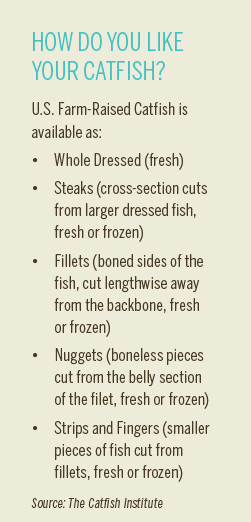Home > Mississippi > Mississippi Crops & Livestock > Delectable Delacata
Delectable Delacata
In partnership with: Mississippi Department of Agriculture and Commerce
 After turbulent times in the last few years, things appear to be looking up for Mississippi’s catfish industry and other traditionally strong catfish-producing states in the southeast.
After turbulent times in the last few years, things appear to be looking up for Mississippi’s catfish industry and other traditionally strong catfish-producing states in the southeast.  An industry that flourished in the 1980s and ’90s began to struggle about a decade ago due to higher feed prices and competition from cheap and inferior so-called “catfish” products imported from Asia. But, with a reduction in grain prices leading to lower feed costs and stronger labeling laws that allow consumers to distinguish true U.S. farm-raised catfish from products coming from overseas, farmers are breaking even and starting to see profits. That is good news for Rick Moyer, who has been in the aquaculture industry since 1985 and has owned Quiver River Aquaculture catfish farm in Sunflower since 1990. “The industry has kind of stabilized in the last few years,” says Moyer, The Catfish Institute’s 2014 Mississippi Catfish Farmer of the Year. “At this point, we’re getting a pretty good price, and it’s economically feasible again to be a catfish farmer. It’s a living anyway.” That living has been given a boost from a labeling law passed in May 2014 under the Federal Food, Drug, and Cosmetic Act. It states that “catfish” must be clearly defined as members of the taxonomic family ictaluridae, or channel catfish. Various Asian fish that were once called “catfish” can no longer be labeled as such. Mississippi and nearby states such as Alabama, Arkansas, Louisiana and Tennessee also have their own labeling laws. “Mississippi probably has the best country-of-origin labeling requirements for restaurants, and this allows the consumer to clearly know where their catfish comes from,” says Roger Barlow, president of The Catfish Institute in Jackson. “Whenever we conduct surveys, we find that 95 percent of those we ask would rather eat American farm-raised catfish than imported.”
An industry that flourished in the 1980s and ’90s began to struggle about a decade ago due to higher feed prices and competition from cheap and inferior so-called “catfish” products imported from Asia. But, with a reduction in grain prices leading to lower feed costs and stronger labeling laws that allow consumers to distinguish true U.S. farm-raised catfish from products coming from overseas, farmers are breaking even and starting to see profits. That is good news for Rick Moyer, who has been in the aquaculture industry since 1985 and has owned Quiver River Aquaculture catfish farm in Sunflower since 1990. “The industry has kind of stabilized in the last few years,” says Moyer, The Catfish Institute’s 2014 Mississippi Catfish Farmer of the Year. “At this point, we’re getting a pretty good price, and it’s economically feasible again to be a catfish farmer. It’s a living anyway.” That living has been given a boost from a labeling law passed in May 2014 under the Federal Food, Drug, and Cosmetic Act. It states that “catfish” must be clearly defined as members of the taxonomic family ictaluridae, or channel catfish. Various Asian fish that were once called “catfish” can no longer be labeled as such. Mississippi and nearby states such as Alabama, Arkansas, Louisiana and Tennessee also have their own labeling laws. “Mississippi probably has the best country-of-origin labeling requirements for restaurants, and this allows the consumer to clearly know where their catfish comes from,” says Roger Barlow, president of The Catfish Institute in Jackson. “Whenever we conduct surveys, we find that 95 percent of those we ask would rather eat American farm-raised catfish than imported.” 
Filet Mignon of Catfish
Mississippi’s catfish industry is also setting itself apart through a relatively new style of catfish known as Delacata, a premium product that comes from the center cut of a regular catfish filet. It’s hand-trimmed and deep-skinned to remove any fat that might be found in a regular catfish filet. “It’s the filet mignon of catfish,” Barlow says of Delacata, which was developed by the U.S. Farm-Raised Catfish industry. “We’re trying to offer a product that the consumer will choose when deciding not to fry. It’s perfect for grilling, sautéing or blackening. If you try Delacata, you would rather have it than grouper, snapper or redfish. It’s the premium of premiums.” Expectations are high that Delacata can help fill a niche in the farmers’ ponds and the catfish industry as a whole. The competitively priced filet is still in test markets in restaurants and grocery stores, primarily in the Jackson area. But as more people are trying it, distribution could expand in the not-too-distant future. That would be a win-win, Barlow says, as both consumers and farmers would benefit. “You can certainly offer the consumer a wider variety of choices, and in turn, that can provide the farmer a higher-profit item,” he says. “I think it’s only a natural move to go into a more elite area, and it’s one thing the imports can never have. “It does offer the entire industry that opportunity for the value-added product we’re all seeking.”



